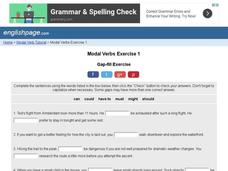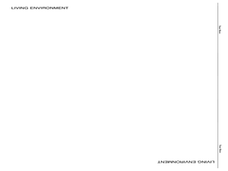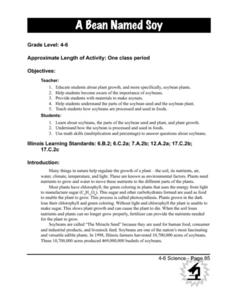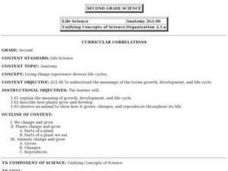Curated OER
Let's Learn About Lettuce
Learners learn more about lettuce. In this agriculture lesson plan, students listen to their instructor lecture about the history of lettuce. Learners then participate in an activity that requires them to compare and contrast iceberg...
Curated OER
Using Present Perfect Continuous
In this present perfect continuous verbs worksheet, students fill in the blanks in 20 sentences with 1 of the verbs ending in -ing listed in the word bank. Students also write their own sentences using have or has and present continuous...
Curated OER
Our Friends the Trees
Students explore trees and learn about their importance to the environment. In this tree study lesson, students work in groups to complete a tree survey, a map for the survey, and several worksheets about the tree topics. students make a...
Curated OER
From Seed to Plant
First graders listen to the book, FROM SEED TO PLANT by Gail Gibbons and identify the process by which a seed becomes a plant. They discover the names of the parts of a plant as well as what is needed for it to grow. They wrap up the...
Curated OER
Modal Verbs Exercise 1
In this online interactive grammar skills activity, students answer 20 fill in the blank questions regarding the use of modal verbs. Students may submit their answers to be scored.
Curated OER
Raven Chapter 35 Guided Notes: Plant Form
The ups and downs of plant vascular tissue are described by your beginning botanists as they complete this worksheet. Xylem and phloem are defined and identified on actual color photographs. Functions of the different types of meristem...
Curated OER
Regents High School Exam: Living Environment 2008
Tne New York Regents High School Examinations are comprehensive and include various styles of questions, includingmultiple choice and the analysis of graphs. This particular version, the 2008 Living Environment exam surveys a variety of...
Curated OER
Defining Drought
High schoolers examine the hydrologic impacts of drought. Humans can change the course of the water cycle, to some extent, to meet their needs, but can they do so without imposing risks on the plants and animals?
Curated OER
Soybeans: The Miracle Seed
Students discover why soybeans are called the "miracle seeds." They make their own soynuts and share other foods made from soybeans. They create a bulletin board of soybean products.
Curated OER
Beetle Collection and Release
Students investigate plants and compare them to the purple loose strife. As they observe the plants they predict possible impacts on plant populations based on their observations. They work in groups and present their findings to the class.
Curated OER
Rainforest Plant or Animal?
Young scholars explore the major functions of plants and animals. In this rainforest lesson plan students create a Venn diagram to compare and contrast animals in the rainforest.
Curated OER
Climatic Zones
Third graders recognize and locate Frigid, Temperate, and Torrid climatic zones on the word map or globe. They explain that plants, animals, and human societies display adaptations to the climates they live in .
Curated OER
Bud the Spud Moves West
As part of a unit on Canadian agriculture, this focuses on how potato farms have increased in the west. Pupils participate in a discussion about the impact of consumer demand on production, and then they read an article about potato...
Curated OER
Living Things Experience Diverse Life Cycles
Second graders will study and explain the meaning of growth, development, and life cycle. They describe how plants grow and develop and observe an animal to show how it grows, changes, and reproduces throughout its life.
Curated OER
Science: Fossil of a Carbonized Plant
Students classify leaves by shape and margins and use them to create models of plant fossils. By using paper over a leaf, they simulate fossilization of organisms onto sedimentary rocks. Following instructions on worksheets, students...
Curated OER
Biology of Bats
Your class will love exploring animal conservation through this instructional activity on bats. Learners discuss the importance of bats in the ecosystem and talk about the different types and their characteristics. As a follow up, a...
Curated OER
My Own Backyard
Scholars create a drawing of their own backyards. They will use a visualization technique to sketch their own backyard onto construction paper using oil pastels. Guiding questions are given along with materials for the project....
Curated OER
Get In Touch With Trees
Students feel tree parts inside of 3 mystery boxes. Then they go outside and find the 3 trees the parts came from. They draw their favorite tree including details of the part they felt.
Curated OER
Week 3: Pollution Source and Effects
Lab groups set up an experiment to observe what happens over time in collected pond water when fertilizer, representing pollution, is added. This website does not include student lab sheets, but background information, materials, and...
Curated OER
Habitats
Students examine how different living things interact with their environment. As a class, they discuss the characteristics of a habitat and write the list on the board. In groups, they focus on one habitat and create a mural of the...
Curated OER
A Perfect Pond Study Lesson Plan
Learners take a field trip to a wetland ecosystem. An informal pond study is performed by students. They examine their favorite animal, write a description of how it moves and illustrate it. In groups, learners draw pictures of organisms...
Michigan Sea Grant
What's in This Water?
Pupils investigate the biological and chemical characteristics of water to determine where purple loosestrife occurs. They create data sheets to record water quality tests in several locations and work in groups to conduct the water...
Curated OER
Biosphere Starts with?
How can your pupils test their biosphere vocabulary acquisition? They can do it by using a fill-in-the-blank worksheet like the one found here. Thirty-four common words and phrases surrounding the topic are included. There is a number 35...
Curated OER
Animals A to Z: Porcupine
In this porcupine worksheet, 3rd graders will add pages to their "animal books." Students will read 10 facts to gain an understanding of a porcupine and its particular attributes.























